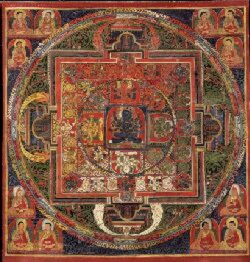Abhiṣekha
Abhiseka is the name used to describe a number of ritualistic practices in Indian religions. abhiseka: Literally "sprinkling" whereby a disciple receives initiation or empowerment. Sometimes refers to the vows taken with tantric initiation or the third set of vows, the other two being the pratimoksa vows or precepts of the hinayana tradition and the bodhisattva vows of the open mahayana tradition.
Hinduism
Abhiseka is the name given to a late Vedic rite of anointing government officials, particularly heads of state, at the time of their taking power or to mark a signal achievement. It is also the bathing ceremony and anointing performed on certain festival days for the temple deities.
Buddhism
The abhiseka ritual in Shingon Buddhism is the initiation ritual used to confirm that a student of esoteric Buddhism has now graduated to a higher level of practice. The ritual was popular in China during the Tang Dynasty, and Kukai, founder of Shingon, studied there extensively before introducing this ritual to the Japanese Buddhist establishment of the time.
The ritual utilizes the one of the two Mandala of the Two Realms, depending on the occasion. In esoteric ritual, the teacher of the esoteric Buddhism assumes the role of the teacher, usually Mahavairocana Buddha, while the master and student repeat specific mantras in a form of dialogue taken from esoteric Buddhist sutras. The student, who is blindfolded, then throws a flower upon the Mandala that is constructed, and where it lands (i.e. which deity) helps dictate where the student should focus his devotion on the esoteric path. From there, the student's blindfold is removed and a vajra is placed in hand.
